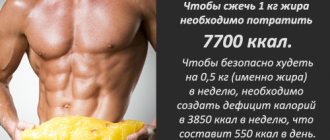The fact that the rule of energy balance (which we once again recalled in the feuilleton “Enzymes in sausages and buckwheat porridge in the mind”) works is beyond doubt for any even slightly educated lover of a healthy lifestyle.
Let's remember this rule: the change in your weight is simply the difference between the calories you eat and the calories you burn.
If you ate more than you spent, you gained weight; you ate the same amount, but spent more, and the weight went off.
So it is believed that 3500 kcal = approximately 0.5 kg of weight . That is, if you ate for a week with a daily deficit of 500 kcal, then by the end of the week you should lose about 0.5 kg of weight. (Why not the rule 7000 kcal = 1 kg? Because in the USA, where it came from, it is customary to count in pounds, and 1 pound is about half a kilo).
Russified “rule 3500 kcal = 1 pound” - “rule 7-8 thousand kcal = 1 kg” from the cartoon Zozhnik.
LiveJournal user shantramora translated a text by the famous scientist Lyle MacDonald about why the 3500 kcal rule is rarely accurate in practice.
Why the “3500 kcal rule” is not accurate in practice
I'm pretty sure everyone knows the old rule: 3500 kcal is half a kilo of weight. This idea of energy balance leads to overly straightforward, “mathematical” calculations of weight loss. It is estimated that simply reducing energy intake by 500 kcal per day - or increasing energy consumption by 500 kcal - should lead to weight loss of half a kilo per week.
But this approach works for almost no one. Or almost never. There are several reasons for this, not the least of which is poor dieting, which leads to less (than expected) weight loss [13]. But even if a person who wants to lose weight strictly adheres to the diet, real changes will differ from the calculated figures.
And for this reason, many people mistakenly believe that the concept of energy balance itself is incorrect, or does not apply to people, etc. But the only mistake is the interpretation of the rule itself , the way it is presented, and why it almost never works as expected. Because, in general, creating a deficit (or excess) of 3500 kcal does not lead to a loss (gain) of 0.5 kg of weight per week [14].
There are several reasons for this misunderstanding.
First, the energy balance equation says nothing about changes in weight; it says that the long-term difference between intake and expenditure determines how much energy is stored or removed from the body. And the first problem we face is that different types of tissue (e.g. organs, brain, muscle, fat, carbohydrates, water) contain different amounts of energy:
In essence, the 3,500 kcal rule only applies to burning fat, not other components of the body. And, by the way, fat is not 100% triglycerides, but only 85-90%. Let's take 87% for good measure. The rest is water and other cellular components.
So in one pound of fat (454 grams) there would be approximately 394 grams of triglycerides, which provide 9 kcal per gram, so the total would be 3,555 kcal. This is where the 3500 kcal rule comes from. But again, I want to remind you that this is not just about fat.
Mono-fasting days for 500 calories
Monodays will provide an additional effect on cleansing the body and losing weight.
They involve the consumption of a single product or dish for one or several days. In order not to harm the body, you need to choose the right food for a mono-diet. Vegetables, fruits, drinks and even chocolate will do.
The most common diet is buckwheat with kefir.
Boiled cereal provides only 102 kcal per 100 g, and low-fat kefir - up to 30 kcal. For one serving, 60 g of kernels and 50 grams of milk drink are enough (it can be replaced with milk, yogurt, whey).
A delicious fasting day - with chocolate. TO
akao promotes the rapid removal of fluid from soft tissues, which results in a loss of 1-1.5 kg per day. This diet is strict, it should not be long, it is better to consult a doctor first. Daily diet – 100 g of dark chocolate (from 75%) and green tea. The chocolate is divided into 5 portions.
The difference in the 3500 kcal rule: depending on what you lose/gain: water, muscle or fat
As a rule, when you are in a calorie deficit, it is not just fat that is lost. For example, water, although it does not contain calories, its fluctuations can significantly affect weight as such.
Incorrect application of the 3500 kcal rule will lead to the assumption that to gain 2 kg of weight you need an excess of 14,000 kcal. The same applies to losing 2 kilograms of water - it is clear that you cannot create a deficit of 14,000 kcal in a day . But it doesn’t have to be such a big deficit, because part of the weight lost will be water, which has no calories.
It's this misunderstanding that has given rise to the myth that low-carb diets provide some particularly cool metabolic advantage.
How does low carb work?
Typically, a sharp decrease in the amount of water in the body in the first few days of a low-carb diet (from 1 to 6 kg) is mistaken for a huge energy expenditure. But given that water contains no calories, the impression is wrong. If you return the same 1-6 kg of “water” weight to its place, the effect will be the same, that is, zero. Water contains no energy.
The fact that carbohydrate reserves in the body are often used up and replenished quite quickly also seems to break the rule.
But, firstly, 0.5 kg of carbohydrates does not contain 3500 kcal. There are about 2000 of them there.
Secondly, carbohydrates bind water, approximately 3-4 grams of water per gram. So, when replenishing the supply of carbohydrates by about 500 grams, in terms of energy we will get 2000 kcal, and in terms of weight – 500 g of “coals” + 1500 g of water. Approximately +2 kg. At the same time, the 3500 kcal rule is still not violated.
And this is an important detail, since at the initial stage of the diet, the consumption and replenishment of glycogen and water reserves can be quite noticeable . Let's say, in the first few days of the diet, a person may notice a significant weight loss of 2-3 kg. But this weight contains very few calories (no water at all, and a few carbohydrates), and in fact this sharp weight loss does not mean anything.
500 calorie diet for weight loss: benefits
The main benefit of the 500 calorie diet is that it helps in rapid weight loss. Following a VLCD can help refresh your metabolism. It accelerates fat oxidation, helping you lose weight. This is great for those who need to lose weight to prevent any health risks.
But what if you're on this diet even if you don't need to? Or what if you are on a 500-calorie diet for three weeks or more without a doctor's supervision? Here's what can happen.
What body composition, not what weight
We are interested in body composition, changes in the tissues themselves, % fat and skeletal muscle / dry mass. And not only do they contain different amounts of calories, they are also consumed (burned) in different proportions, depending on gender, diet, initial percentage of fat, etc. Body protein also contains water (just like fat), so when it is broken down, water also leaves, and your weight may change a little more than calculated.
A woman's body is more likely to use fat for fuel (and burn less lean mass) than a man's, so a diet with enough protein and regular strength training will help maintain muscle mass (which means you'll burn more fat) . A person with a higher body fat percentage also loses less lean mass (and more fat).
In this latter situation, a very overweight person, if we ignore (ignore) water and glycogen, may well come quite close to the calculation model based on the “3500 kcal rule” ; it can also quite accurately describe the process at a later stage, when more fat has been burned. But in general, it’s always worth remembering that losing weight by those notorious half-kilograms takes longer than you might expect by roughly applying the “3500 kcal rule.”
Lyle MacDonald is a sports physiologist, nutritionist and author of many books on recomposition, fat loss and muscle growth.
What is the 500 calorie diet for weight loss?
The 500 calorie diet is an extreme form of the very low calorie diet, meaning it is extremely low in calories. It replaces your regular diet with liquid supplements that replace meals with shakes and drinks over a period of time.
This limited calorie intake will help your body utilize its stored fuel source i.e. fat. This, in turn, will help you lose extra pounds.
This is a type of 5:2 intermittent fasting plan that involves severely restricting energy on two non-consecutive days of the week and consuming 2,000 calories on the other five days. This type of modified diet can meet 20-25% of energy needs on fasting days.
Research has shown that hypocaloric intermittent fasting can help overweight and obese people lose weight. However, these studies are not conclusive and more research is needed to confirm these findings.
What should your 500 calorie diet plan look like? Scroll down to find out.
Why does weight come off faster on Dukan? Because more muscle is lost
Let's look at this example. Let's say a person who is in an energy imbalance - in a deficit - spends 10% of energy from dry mass and the remaining 90% from fat reserves. It creates a deficit of 3500 kcal per week.
10% of the weight (350 kcal) comes from lean mass/muscle protein, which is only 600 kcal per pound. That's less than 230 grams of weight lost. The remaining 3,150 calories will come from fat (about 0.9 pounds of fat). So, in general, in a week you will lose 634 g of weight (230 g of dry mass and 404 g of fat).
This means that weight will be lost faster if more lean mass is burned , and I suspect that all sorts of centers and commercial weight loss programs recommend refraining from strength training for this very reason (this is the key to the ban on strength training on the Dukan diet!)
Exercising forces the body to conserve muscle while dieting (which is good), but weight loss is faster if more lean mass is lost. Imagine an absurd situation when all the weight is lost from the muscles, energy is consumed 100% from dry mass. Considering its low calorie content - about 700 kcal per pound, with the same deficit of 3500 kcal per week, you can lose as much as 2.5 kg of weight (due to muscles). But the composition (body composition) in terms of % fat will only worsen. Keep in mind, this isn't actually possible, I'm just taking such an extreme example to explain.
Please note: the owner of the butt on the left is simply starving to lose weight, losing muscle, and the proud owner of the butt on the right is doing squats... She also does massage, photoshop, and possibly silicone.
But in order to burn half a kilo of fat in this situation, you will need to make a deficit of 10% greater than 3500 kcal, since 10% of the energy is consumed in the breakdown of protein. So, to lose half a kilo of fat, you need a deficit of 3850 kcal, considering that 90% of energy comes from fat.
In fact, the 3500 kcal rule “doesn’t work” only because of a misunderstanding of the rule itself. It applies to fat burning if 100% of fat is burned. In the early stages of a diet, when water and glycogen are lost, more weight may be lost. And then, if the energy is not taken 100% from fat, then the rates will, at a minimum, differ from the calculated ones [15].
How many calories do you need to burn to lose 5 kg?
In 1958, scientist Max Wishnofsky determined that one pound of fat in the human body corresponds to 3,500 kilocalories. Thus, one kilogram of fat is equal to 7,716 kcal.
This means you need to create a deficit of 7,716 kcal to lose 1 kg.
Let's say your goal is to lose 5 kg. You consume 2,000 kcal per day, and spend 2,500 - creating a deficit of 500 kcal. If you stick to this diet, you will lose a kilogram in 15 days. And to lose 5 kg, you will need 2.5 months.
To gain muscle and fat, you need more calories than you get from burning them.
In addition, there is another aspect that, as usual, complicates everything. It takes a little more calories [than the tissue itself] to gain weight. So, if, when broken down, half a kilo of muscle gives only 700 kcal, then to build half a kilo of muscle, you need 2000 kcal or even more (the exact number is extremely difficult to calculate).
So, even with an excess of 3500 kcal, and even if you gain muscle alone, you will not get 2.5 kg of muscle, but something closer to 800 grams, since it takes 2000 kcal to build 450 grams of muscle. And, most likely, the amount of muscle gained will be even less, since part of the stored energy comes from carbohydrate stores, in addition, part of the weight gained may be fat, etc.
To store fat from food, not much more than 3500 kcal is required, although even fat is not stored with 100% efficiency.
So gaining fat will also require a little more calories, in addition, part of the weight gained will inevitably come from lean mass, and the amount of fat stored will still differ from the excess calories taken in.
But there is another extremely important factor that most people ignore or misunderstand. And perhaps it is even more important than the interpretation curve of individual aspects of the energy balance.
Converting calories to kilograms
If we count how many grams of pure fat are contained in calories, then 1 g of pure fat contains 9 kcal. I wonder why the numbers are different? Subcutaneous fat contains not only pure fat, but also water, connective tissue and other compounds. Thus, 1 g of subcutaneous fat contains 7.7 kcal. Fortunately, this is less than in pure fat.
Helpful information! You can safely lose 1 kg in a week. To do this, you need to know how many kcal are in a kilogram.
To lose exactly 1 kg per week, you need to make a daily deficit of 1000 kcal. Then the body will lose weight without any harm to health.
Note! To lose or gain weight, the main thing you should know about food is how many kilocalories there are in a kilogram of certain foods.
To lose weight, it is advisable to consume the following vegetables, fruits and berries, because they contain a minimum of calories:
- cucumbers;
- tomatoes;
- watermelon;
- apple;
- broccoli;
- cauliflower;
- fresh juices;
- celery, etc.
To find out what caloric intake you need to follow, a calorie counter will help. You can use the Maflin-Saint Jeor calculator online or calculate using simple calculations:
- For a woman = (9.99* weight (kg)) + (6.25* height (cm)) - (4.92* age) - 161;
- For a man = (9.99* weight (kg)) + (6.25* height (cm)) - (4.92* age) + 5.
For both men and women, an adjustment is made for the activity factor to know how many calories you need to burn per day to lose weight. For this Kcal*k, where:
- k=1.20 (at low activity);
- k=1.38 (with low activity);
- k=1.55 (with average activity);
- k=1.73 (at high activity).
500 kcal nutrition plan
There are various options for the daily menu. But the dishes offered do not always suit taste preferences. In this case, you can think over the daily diet yourself . Choose your favorite low-calorie foods and include more fruits and vegetables in your menu.
Here is one of the suggested options:
- for breakfast, coffee without sugar and cream (8 kcal) and a medium-sized apple weighing 150 grams (72 kcal);
- snack – orange (65 kcal);
- for lunch, 200 grams of vegetable soup (90 kcal) and a salad (88 kcal) of two tomatoes, one cucumber and 20 grams of cheese;
- snack – banana (77 kcal);
- dinner should consist of 100 kcal, this could be a few red carrots.









